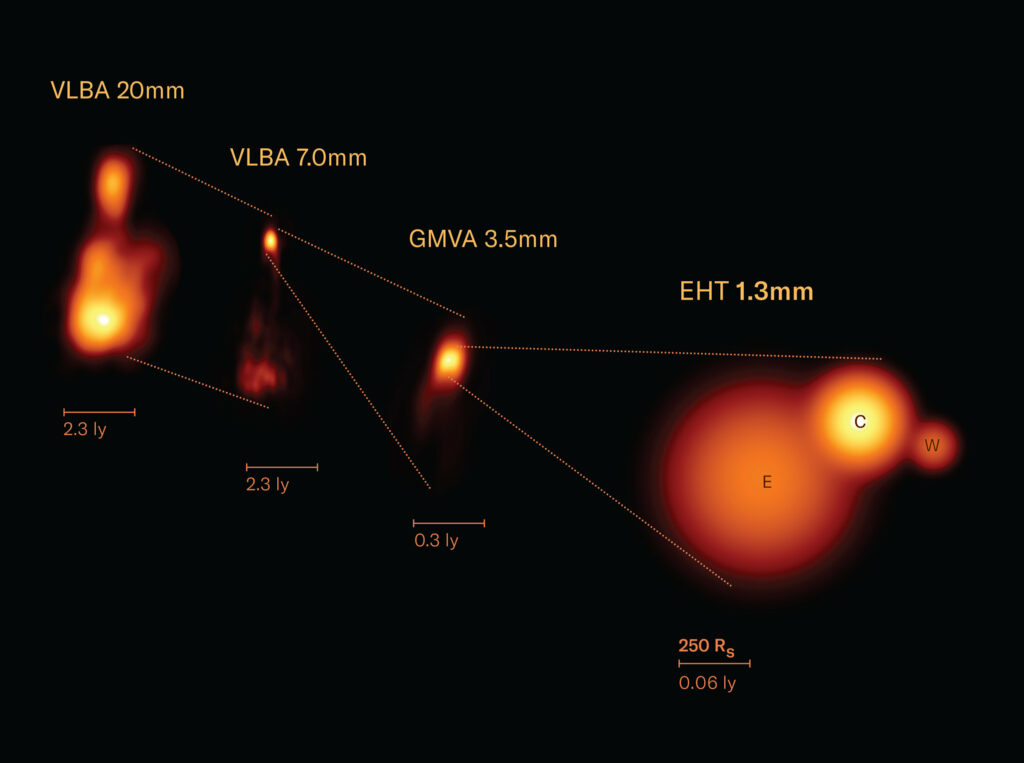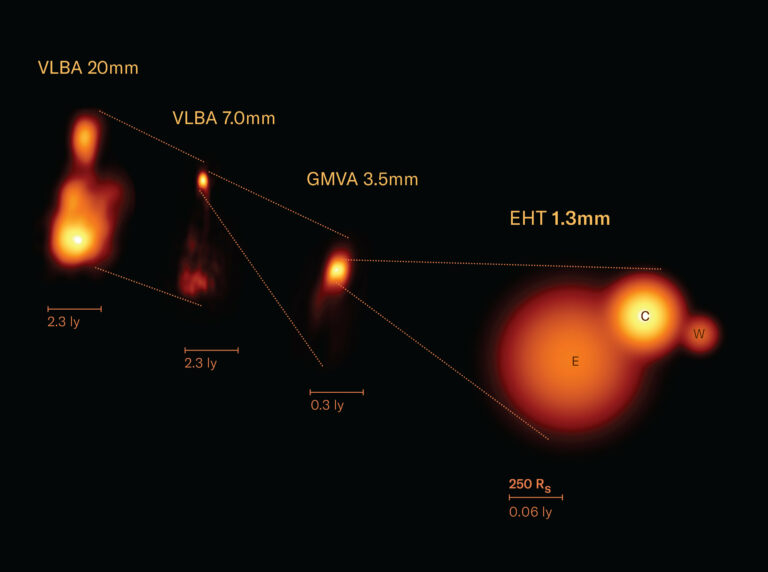Launching Black Hole Jets in Perseus A through Magnetic Mechanisms
The jet base of a developing plasma jet has been successfully resolved by the collaboration of the Event Horizon Telescope, which includes scientists from the Max Planck Institute for Radio Astronomy in Bonn, Germany. Using this Earth-sized telescope, the international team of scientists examined the magnetic structure within the core of the radio galaxy 3C 84 (Perseus A), which is one of the closest active supermassive black holes in our cosmic vicinity.
These groundbreaking findings offer fresh understanding of the launch mechanism of jets, demonstrating that in the cosmic struggle, magnetic fields triumph over gravity. The study has been published in the journal Astronomy & Astrophysics.
The powerful radio source 3C 84, also known as Perseus A, corresponds to NGC 1275, the central galaxy in the Perseus cluster located 230 million light years away. It harbors a relatively nearby active galactic nucleus, enabling a meticulous examination of the central source at a high level of detail using the Event Horizon Telescope (EHT).

“Alongside its ability to capture the first images of black holes, the EHT is exceptionally well-suited for observing astrophysical plasma jets and their interaction with intense magnetic fields,” states Georgios Filippos Paraschos, a researcher at the Max Planck Institute for Radio Astronomy (MPIfR) and the leader of the project. “Our latest discoveries provide further evidence that an organized magnetic field extends throughout the heated gas surrounding the black hole.”
The remarkable discoveries made by the EHT have allowed scientists to investigate long-standing inquiries regarding the mechanism through which black holes accumulate matter and emit powerful jets that extend beyond their host galaxies.
Recently, the Event Horizon Telescope has revealed images that depict the path of light oscillation surrounding the M 87* black hole. This characteristic of the emitted light, known as linear polarization, offers insights into the underlying magnetic field. Specifically, the presence of strong linear polarization, as observed in the current study, suggests the existence of a robust and well-organized magnetic field in the vicinity of the 3C 84 black hole.
Significantly, these intense magnetic fields are believed to be the driving force behind the initiation of plasma jets, which consist of matter that has not been consumed by the black hole.
Jae-Young Kim, an associate professor of astrophysics at Kyungpook National University in Daegu, South Korea, and also affiliated with the MPIfR, remarks, “The radio galaxy 3C 84 is particularly intriguing due to the difficulties involved in detecting and accurately measuring the polarization of light near its black hole. The Event Horizon Telescope’s exceptional ability to penetrate the dense interstellar gas represents a groundbreaking advancement in precisely observing the vicinity of black holes.”
These highly precise observations pave the way for the discovery and study of other supermassive black holes that have remained concealed and elusive to previous observational technologies.
Their discoveries also provide insight into how mass is accumulated onto the supermassive black hole, which occurs through advection. The matter that falls into the black hole is believed to form a highly magnetized disk known as a magnetically arrested disk.
In this situation, the magnetic field lines within the disk become tightly wound and twisted, hindering the efficient release of magnetic energy. Additionally, the study suggests that the black hole 3C 84 is rotating rapidly, which suggests a connection between the launch of jets and the spin of large black holes.
The researcher at the MPIfR, Maciek Wielgus, states, “Why are black holes so proficient at generating powerful jets? This is an incredibly intriguing question in the field of astrophysics. We anticipate that the effects of general relativity just above the event horizon of a black hole may hold the key to answering this question. These high-resolution observations are finally paving the way for observational confirmation.”
These groundbreaking findings have been made possible by utilizing the technique of very-long-baseline interferometry (VLBI), where multiple telescopes observe the same celestial object and combine their collected signals to produce an image. In essence, they function as a virtual telescope with a diameter as large as that of the Earth.
“We are tremendously excited because these results represent a significant advancement in our understanding of galaxies like 3C 84. Together with our international partners, we are dedicated to enhancing the capabilities of the Event Horizon Telescope to gain even more detailed insights into jet formation around black holes,” concludes Anton Zensus, Director at the MPIfR and head of its Radio Astronomy/VLBI research department.
This article is republished from PhysORG under a Creative Commons license. Read the original article.
Do not forget to share your opinion with us to provide you with the best posts !




0 Comments